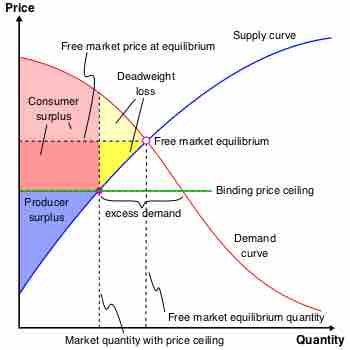A price ceiling will only impact the market if the ceiling is set below the free-market equilibrium price. This is because a price ceiling above the equilibrium price will lead to the product being sold at the equilibrium price.If the ceiling is less than the economic price, the immediate result will be a supply shortage. As you can see from the chart below, a lower base price means less of a good will be produced. The quantity demanded will increase because more people will be willing to pay the lower price to get the good while producers will be willing to supply less, leading to a shortage.

Price Ceiling Chart
If a price ceiling is set below the free-market equilibrium price (as shown where the supply and demand curves intersect), the result will be a shortage of the good in the market. The dead weight loss, represented in yellow, is the minimum dead weight loss in such a scenario. If individuals who value the good most are not capable of purchasing it, there is a potential for a higher amount of dead weight loss.
A price ceiling will also lead to a more inefficient market and a decreased total economic surplus. Economic surplus, or total welfare, is the sum of consumer and producer surplus. Consumer surplus is the monetary gain obtained by consumers because they are able to purchase a product for a price that is less than the highest that they are willing pay. Producer surplus is the amount that producers benefit by selling at a market price that is higher than the least they would be willing to sell for. An effective price ceiling will lower the price of a good, which means that the the producer surplus will decrease. While the effective price ceiling will also decrease the price for consumers, any benefit gained from that will be minimized by decreased sales caused by decreased available supply for sale from producers due to the decrease in price. This translates into a net decrease total economic surplus, otherwise known as deadweight loss. This loss is signified in the attached chart as the yellow triangle.
Rationing
If a ceiling is to be imposed for a long period of time, a government may need to ration the good to ensure availability for the greatest number of consumers. One way the government may ration the good is to issue ticket to consumers. A government will only allow as much of good to be out in the marketplace as there are available tickets. To obtain the good, the consumer must present the ticket and the money to the vendor when making the purchase. This is generally considered a fair way to minimize the impact of a shortage caused by a ceiling, but is generally reserved for times of war or severe economic distress.
Black Market
Prolonged shortages caused by price ceilings can create black markets for that good. A black market is an underground network of producers that will sell consumers as much of a controlled good as they want, but at a price higher than the price ceiling. Black markets are generally illegal. However these markets provide higher profits for producers and more of a good for a consumers, so many are willing to take the risk of fines or imprisonment.